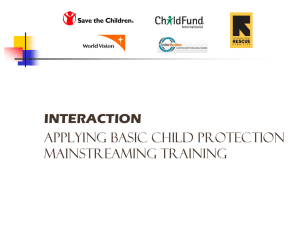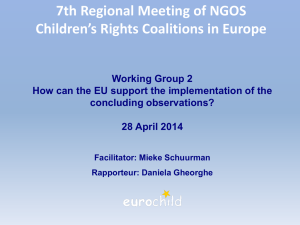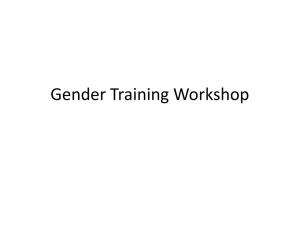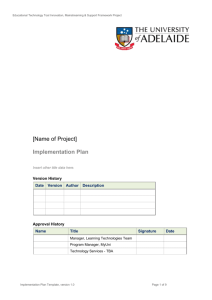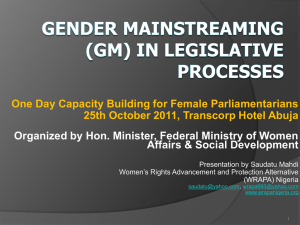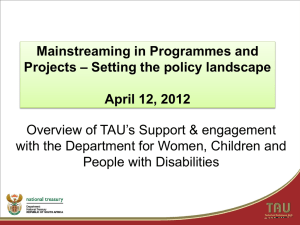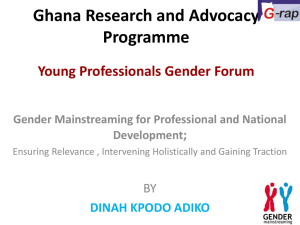Gender mainstreaming: A Political Concept for Europe
advertisement
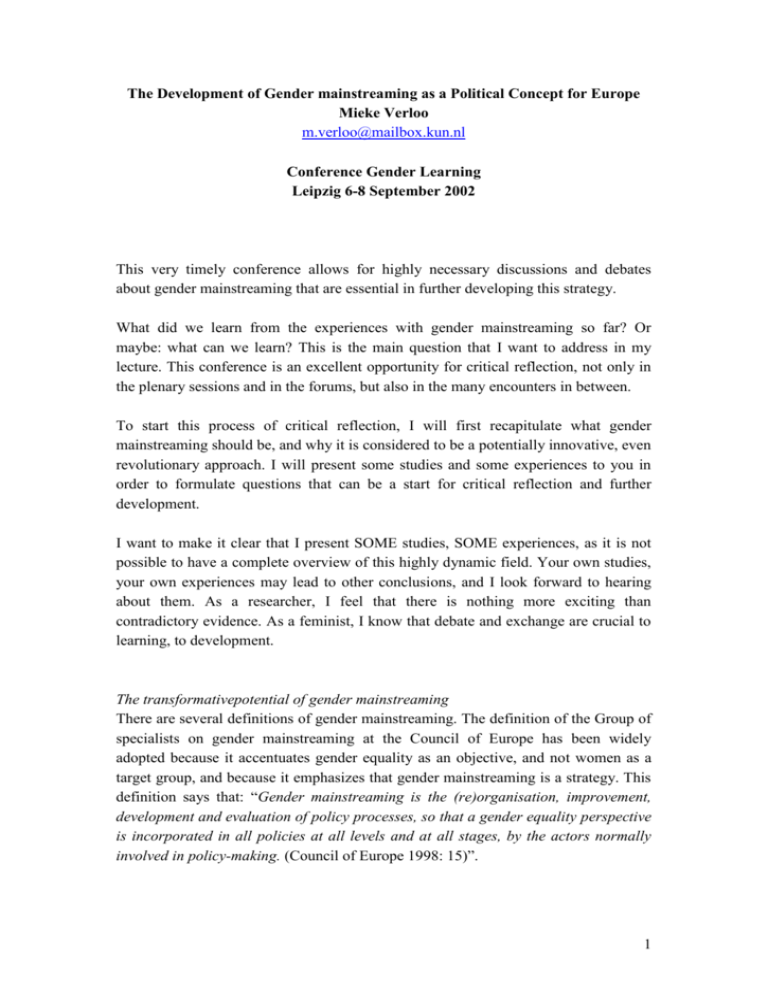
The Development of Gender mainstreaming as a Political Concept for Europe Mieke Verloo m.verloo@mailbox.kun.nl Conference Gender Learning Leipzig 6-8 September 2002 This very timely conference allows for highly necessary discussions and debates about gender mainstreaming that are essential in further developing this strategy. What did we learn from the experiences with gender mainstreaming so far? Or maybe: what can we learn? This is the main question that I want to address in my lecture. This conference is an excellent opportunity for critical reflection, not only in the plenary sessions and in the forums, but also in the many encounters in between. To start this process of critical reflection, I will first recapitulate what gender mainstreaming should be, and why it is considered to be a potentially innovative, even revolutionary approach. I will present some studies and some experiences to you in order to formulate questions that can be a start for critical reflection and further development. I want to make it clear that I present SOME studies, SOME experiences, as it is not possible to have a complete overview of this highly dynamic field. Your own studies, your own experiences may lead to other conclusions, and I look forward to hearing about them. As a researcher, I feel that there is nothing more exciting than contradictory evidence. As a feminist, I know that debate and exchange are crucial to learning, to development. The transformativepotential of gender mainstreaming There are several definitions of gender mainstreaming. The definition of the Group of specialists on gender mainstreaming at the Council of Europe has been widely adopted because it accentuates gender equality as an objective, and not women as a target group, and because it emphasizes that gender mainstreaming is a strategy. This definition says that: “Gender mainstreaming is the (re)organisation, improvement, development and evaluation of policy processes, so that a gender equality perspective is incorporated in all policies at all levels and at all stages, by the actors normally involved in policy-making. (Council of Europe 1998: 15)”. 1 The essential element in this definition of the strategy of gender mainstreaming is its accent on what needs to be changed, targeting policy processes as the main change object. Gender mainstreaming, according to this definition is about (re)organising procedures and routines, about (re)organising responsibilities and capacities for the incorporation of a gender equality perspective. In further elaborations of the strategy, different tactics that are distinguished can concentrate on organising the use of gender expertise in policy-making, or on organising the use of gender impact analyses in this process, or on organising consultation and participation of relevant groups and organisations in the process. Additionally, the accent in gender mainstreaming is on gender, not only – more narrowly – on “women” as a target group. The underlying assumption is that most regular policies are gendered, that regular policies are a major constitutional element in the construction of gendered social institutions, and that gendered social institutions are an important component in the continuous reproduction or reconstruction of gender inequality. Gender mainstreaming usually involves a reorganisation of policy processes, because existing procedures and routines are all too often gender-blind or gender-biased. In contrast to the standard assumption of policy makers and policy-making organisations that their work is gender-neutral, it has been proven over and over again that gender differentials are not recognised in regular policies and that unreflected assumptions include biases in favour of the existing unequal gender relations (Verloo & Roggeband 1996; Siim 1988). Gender mainstreaming as a strategy is meant to actively counteract this gender bias, and to use the normal mandate of policy makers to promote more equitable relations between women and men (Verloo 2000: 13). It addresses “systems and structures themselves – those very institutionalised practices that cause both individual and group disadvantage in the first place” (Rees 2000: 3). Because of this focus on a systems approach, “it has much more potential to have a serious impact upon gender equality than other strategies have” (Rees 2000). If this is the transformative potential of gender mainstreaming, then surely it is absolutely fantastic that there is so much support for it? That it is adopted in all EU countries and in some candidate states as well? If we take the number of pages, or the quantity of promises, or the number of conferences as an indicator, then definitively gender mainstreaming is a success! Every week it seems that some more organisations declare that they start a process of gender mainstreaming… Should we be glad about this? Of course, it all depends on what it is exactly, this gender mainstreaming in practice… I am not the only one to point at problems in the current gender mainstreaming practice. I will point at three problems, and present questions to detect them. 2 Gender mainstreaming in practice: beyond rhetoric? The first problem is that gender mainstreaming does not always move “beyond rhetoric”, that there is a lot of paper and too little action. Concerning this success at the rhetorical level only, I will be brief, as this is a widely acknowledged problem. I will present two questions that are meant to evaluate gender mainstreaming initiatives in this respect. 1. Which part of the mainstream is targeted in a gender mainstreaming initiative? Which measures are taken to avoid a one-report-only case, to ensure sustainable change, a sustainable incorporation of a gender perspective? To give an example: the Gender Impact Assessment in the Netherlands is an adequate instrument, but it is not compulsory, it is not part of the policy-making routines. There is even not any action to move towards an integration of this instrument in the regular routines. Hence: this is not a gender mainstreaming effort, but an instrument that could be used in such a process. In more general terms: if there is no specific part of the mainstream targeted, if no measures are taken to ensure a sustainable process, then there is not sufficient action to be gender mainstreaming. 2. Is there any action at all? What are the intended results of gender mainstreaming initiatives in terms of gender equality? What we see is that it is common to frame results as: we want to make a group of focal points, we want to exchange information. Concentrating on the “means”, rather than on the (intended) results makes window dressing easier. Gender mainstreaming involves action, and it should always be possible to relate gender mainstreaming efforts to results in terms of gender equality. Gender mainstreaming in practice: a twin track strategy? The second problem is that gender mainstreaming competes with other strategies towards gender equality. There are numerous cases of abolition of specific initiatives such as women’s units, gender equality units, women’s rights committees or support for feminist groups. All in the name of gender mainstreaming. In theory, targeted action and gender mainstreaming are complementary, in practice they are competing. This is dangerous. Gender mainstreaming cannot fully develop, cannot thrive in a climate that does not allow the articulation of feminist organisation, be it inside institutions or autonomous. Gender equality units are a valuable asset for gender mainstreaming, they do not become redundant. Their position should be strengthened, not weakenedi. I therefore present the following –third- question to evaluate gender mainstreaming initiatives, to design good plans. 3. Does the gender mainstreaming initiative articulate where, how and when, and towards which target groups specific action might be urgent? One can safely assume that some specific action might be necessary. The idea is to work actively towards complementarity, and to put responsibility with the initiators of the new “invasive” strategy. The answer to this question should be yes. 3 Gender mainstreaming in practice: a strategy in search of an objective? Currently all attention seems to be focused on the development of tools and methods, on pilot implementation projects. This is necessary of course, but there is too little attention to the various definitions of the goal of gender equality that are hiding under the cover of this strategy. As all successful political and policy concepts, gender mainstreaming has a high “stretch” factor. It is stretched to mean gender equality, or equal opportunities, or just gender impact assessment, or attention for diversity issue, or more women in higher positions, and so on. Its ability to be stretched is part of its success. One concept fits all. Still, the stretch factor is also a problem if we want to improve, or even monitor its results. Because then, we need to know precisely what we consider essential, what we consider crucial for its transformative potential. To do so, I turn to the definition once more, to point at its essential elements: The (re)organisation of policy processes The gender equality perspective The regular actors. I will now present some studies to clarify what is the third problem, what are the further challenges ahead in developing gender mainstreaming. State of the art in research on gender mainstreaming Gender Mainstreaming is a recent strategy, and the few studies that exist at the moment stress that it is too early for evaluation. Still, there are some studies available, and I will review them to assess the state of the art knowledge in this field. The study of Rees (1998) was among the first, and her path breaking work on Gender Mainstreaming in education, training and labour market policies is a major reference. She argues that Gender Mainstreaming is potentially promising, yet poorly conceptualised and inadequately understood, and that there is a need to address the fundamental nature of gender contracts, and the underlying ideology of the white nuclear family that underpins so many of our social institutions. She calls for a clear vision. The other work mostly mentioned by all scholars of Gender Mainstreaming is the Final report of the group of Specialists on Gender Mainstreaming of the Council of Europe (1998). It is their definition of Gender Mainstreaming that I used earlier [the (re)organisation, improvement, development and evaluation of policy processes, so that a gender equality perspective is incorporated in all policies at all levels and at all stages, by the actors normally involved in policy-making] because it has been 4 diffused widely. I believe the report has been useful to clarify gender mainstreaming as a strategy, and can still be useful, especially “for beginners”. The Council of Europe report has been followed by a number of collections of good or best practices. Reports putting the accent on collection of good practices mostly suffer from a clear presentation of criteria to decide what is a good practice and why. As most of these studies try to advocate a more wide dissemination of the Gender Mainstreaming strategy, there seems to be an overdose of enthusiasm, and a lack of criticism. Examples are: Recipes 2000, Athens report Council of Europe 2000, McKay & Bilton 2000. There are only a limited number of more reflective studies, and very little academic research. This section will review the most promising ones, to be able to distinguish what still needs to be done. Although there are but a few reviews available at this moment, mostly fragmented, it is striking that their conclusions seem to point in similar directions. First of all, there is a major accent on Gender Mainstreaming in connection to employment or labour market issues. Behning & Serrano Pascual (2001) concentrate on the impact of the concept of Gender Mainstreaming in national practices on employment, covering twelve Western European countries. They find differences in Gender Mainstreaming parallel to divergent national paths pursued towards the goal of gender equality. As shown by the national reports in their book, the understanding and adaptation of the Gender Mainstreaming concept varies widely in the Member States of the EU, ranging from the equation of the concept with equal opportunities and equality to its being understood as affirmative action, equal treatment, equal participation, reform of government. As a result, they state that there is not a general understanding of the concept in the various Member States, and they conclude – even more importantly – that most policies implemented in Member States are just a continuation of previous policies. The main problem is a focus on women as the subject of change, and a focus on fitting women into the status quo rather than transforming the status quo. In Spain for instance, Gender Mainstreaming in practice is just the reinforcing of positive discrimination policies. Behning and Serrano Pascual stress the importance of a clear understanding of Gender Mainstreaming because an adequate implementation requires a gender perspective in all decision-making processes. As they analyse Gender Mainstreaming in the EU as a top-down strategy – which implies an attempt at harmonisation of European gender cultures – they regret the failure of institutional actors to include actors from the women's movements in the development of the strategy. They plea for a stronger participation of citizens and women's movements in order not to loose a great deal of knowledge and implementation opportunities. They conclude that it is particularly important to clarify the meaning of Gender Mainstreaming. 5 I would go further than “clarify the meaning”. What the work of Behning and Serrano Pascual shows, is that we cannot afford to discuss gender mainstreaming as a strategy without discussing its goal. What is conceptualised as a “gender equality perspective” in the definition needs an elaboration in each and every gender mainstreaming initiative. In the differentiated European countries there are several “gender equality frames”, different and sometimes competing ideas about what the problem is, about who is responsible for the problem, about what are the causes and effects, and about what would be a solution. Or, to put it in the words of a young Swedish feminist: gender mainstreaming cannot replace politics (Bjork 2002). Another review work focuses on specific Gender Mainstreaming tools. The EU’s expert group on Gender and Employment EGGE recently published a report on Gender Impact Assessment (GIA) and the European Employment strategy (Rubery & Fagan 2000). GIA is one of the most developed instruments for Gender Mainstreaming (Verloo & Roggeband 1996). A GIA identifies positive or negative outcomes of proposed policies in terms of gender equality. GIA’s are meant to inform decision-making in an early stage so as to be able to reorient or mitigate policies if necessary. As an instrument, GIA is developing at uneven rates across Member States, the group concludes, with Sweden and the Netherlands taking the lead. The report stresses that even as more practical elaborations of the GIA methodology are necessary, what is most urgent is a further conceptual elaboration. What the report calls an “upwards” elaboration, means that GIA guidelines need to be located in a broader and more explicit theoretical statement of how gender inequality is reproduced in society, and that a classification about the concept of equality is to be adapted. The “downwards”, more practical elaboration then follows from this conceptual framing of gender relations and gender inequality. According to the report, a more developed conceptual framework can inform GIA, and lead to improved GIA methodology, to avoid GIA’s that merely make gender visible, but fail to be gender sensitive. This is all the more important because they find there is a lack of expertise in policy evaluation in general, and of methods for Gender Mainstreaming evaluation specifically. Another major issue that is brought to the fore by the report is how to combine GIA with attention for other forms of structural inequality. They point out that this question will gain increasing prominence because the new European Social Policy Agenda sets out a number of proposed actions on discrimination on other grounds than gender. This calls for a sound understanding of dimensions of gender inequality as related to other structural inequalities, such as ethnicity, age, class, sexual orientation and physical ability. Jill Rubery and Colette Fagan point once more towards more attention for the goal of gender mainstreaming. They call for more 6 theory on what is the problem of gender equality; they call for attention for the links between gender inequality and other structural inequalities. When we continue our overview, we find similar conclusions in the TSER project on “Predicting the Impact on Policy” co-ordinated by Sue Nott, Fiona Beveridge and Kylie Stephen (2000). According to these researchers, diversity in concepts of equality is inevitable, and has positive as well as negative consequences. Because of this diversity, strategies also need to be democratic. In a pluralist understanding this can be seen as a facet of subsidiarity, which in turn is an element of democracy. The first academic studies centre on explaining conditions for a successful start of Gender Mainstreaming (Mazey 2000; Hafner-Burton & Pollack 2000). Mazey shows how Gender Mainstreaming constitutes a clear example of policy succession or policy adaptation, prompted by the desire to overcome the limitations of existing policies, and the need to respond to a changed policy environment. In Hafner-Burton’s and Pollack’s analysis of Gender Mainstreaming in the European Union, it is pointed out that the EU until recently has pursued its ambitious agenda on gender equality mainly along the comparatively narrow neo-liberal front of workplace legislation, but that it has begun to pursue a broader agenda in the 90s, with potentially important consequences for European women and for the EU as a progressive polity. Their work concentrates on this expansion of the EU agenda, and on explaining cross sectional variation within the EU in the start and implementation of Gender Mainstreaming. They consider five areas: Structural funds, Employment and Social Affairs, Development, Competition, and Science, Research and Development. Even if Hafner-Burton and Pollack offer a rather sweeping analysis of the policy frames involved, and framing processes related to them, their analysis shows the dominance of framing as an important aspect of explaining the occurrence and successful starting of the implementation of Gender Mainstreaming. They use the concept of strategical framing as a dynamic concept that enables to see how different actors adapt existing policy frames to pursue their respective goals. (Strategical framing is defined as attempting to construct a fit between existing frames and the frames of the change agent.) Their case studies support two general conclusions: the variability of results, and secondly, the ability of strategic actors to overcome structural obstacles through a skilful process of strategical framing. In their final conclusions, they warn the EU that their Gender Mainstreaming efforts might turn into an integrationist approach – integrating women and gender issues into specific policies rather than rethinking the fundamental aims of the EU from a gender perspective. They see this as the inevitable result of the strategical framing processes who “sell” Gender Mainstreaming as an effective means to the ends pursued by the policy makers, rather than as an overt challenge to those ends. Especially since the EU 7 is one of the most successful implementers so far, this threatens the transformative potential of Gender Mainstreaming. The study of Braithwaite (1999) concerns Gender Mainstreaming in the Structural Funds exclusively. Her study on what can be seen as the most developed area within the EU so far, comes to similar conclusions as the research discussed earlier. It states that many important areas of Structural Funds intervention in terms of gender equality are missed, and that the relevance of gender is sometimes highly contested. It stresses that one of the general risks of the Gender Mainstreaming approach is linked to the absence of precise objectives on reduced gender inequalities. As a result, the treatment of gender can be easily located within, and then be subject to, other policy goals, such as employment creation, economic growth or poverty reduction. So far, she says, the main objective in terms of the Structural Funds and gender equality is to improve female participation in the labour market. Reconciliation of home and professional life is then treated as a means to facilitate women's more active participation in the labour market, rather than as an equality objective in its own right. Contrary to the rhetoric of Gender Mainstreaming, efficiency and effectiveness are, in practice, more convincing arguments for integrating equality concerns into Structural Funds programmes than “equity”. An evaluative report that I have made for the Council of Europe (Verloo 1999a) concludes also that there is a lack of elaboration of gender equality as a definite objective, and a need for ongoing dialogues on what gender equality should be. It states moreover that the main accent in Gender Mainstreaming so far has been on analytical and educational tools, (except at the local and regional level), and that consultation and participation of citizens or users is less used, which threatens to turn Gender Mainstreaming into a technocratic enterprise. Gender mainstreaming in practice: the Dutch Case I will now turn to some more experiences with gender mainstreaming in the Netherlands before presenting some more questions and conclusions. I will use the Dutch manual on gender mainstreaming (Emancipatie in beleid: Handleiding Mainstreaming) as one analytic case, and additionally refer to an inventory of Dutch best practises on gender mainstreaming commissioned by the government in 2000. Turning to the inventory of Dutch best practises on gender mainstreaming, two elements are striking. First of all, there is no mentioning whatsoever of the objective of this strategy. The inventory is based on the answers to a questionnaire that starts with the question: Can you describe the mainstreaming activities that you have been involved with? Continuing with: what was the objective of this initiative? The report gives no information on what could possibly count as The Gender Equality Objective, 8 and does not analyse the answers given to the second question. Answers given to the second question are mostly of the type: we want to brainstorm on gender mainstreaming, or we want to disseminate information. Referring to the objective as related to gender equality is rare. Secondly, the inventory does not seem to have clear criteria on what counts as gender mainstreaming, but uncritically accepts the presentation of activities as such. As a result, activities such as a special fund for women, a plan to stimulate more women in decision making positions, a database on feminist documentation centres, research on women in top positions are all mentioned as gender mainstreaming activities, even if they are clear (and GOOD) examples of targeted gender equality policies. They are mentioned along with gender mainstreaming instruments such as GIA’s, and many conferences and explorative studies. We can conclude that this inventory is a missed opportunity of clarifying both the concept and the practises of gender mainstreaming. When we turn to the manual, we can hardly escape being critical once more. To start on a slightly more positive tone, the manual rightly describes gender mainstreaming as a strategy. It also mentions that it is a continuous, process-oriented strategy, that it is never finished. It does not, however, point out that this means that the organisation (or the anchoring) of the incorporation of a gender perspective is essential, and accordingly, gives no ideas how to do thisii. The two criticisms that I will concentrate on concern the lack of attention to the objective of the gender mainstreaming strategy and the way this manual refers to the necessity of strategical framing. The manual does not explain that gender mainstreaming is a strategy towards gender equalityiii. It comes as no surprise then, that there is no explanation what the goal of gender mainstreaming should be, no mentioning what gender equality, or “emancipation” – to use the Dutch term – as a goal should be. This is striking because gender mainstreaming as a strategy in meant to involve “regular” actors, who cannot be expected to have knowledge about this. How does the manual refer to “content” at all? The manual refers to content using the concept of problem definitions. The manual explains that problem definitions are crucial in enhancing the possibilities for problems to reach the agenda. It gives an example where “emancipation” (not really a problem, but a goal, but this is a side remark), is a concept that has generated too much resistance, similar to words like “gender”, and “women”. Chosen concepts matter, the text goes on, and therefore often concepts like “diversity”, or “equality”, or “participation in society” have been chosen rather than gender or women or emancipation. This section on problem definition ends by explaining that “linking with existing mission statements, goals or concepts of organisations is a good strategy to get the aspect emancipation on the agenda”. 9 After this close reading of the text, we can conclude that the manual does not clarify what the goal of gender equality is or should be, and that it calls for an “anything goes, as long as it sells” approach. It would be naive to think that this will lead to a proliferation of interesting conceptualisations of the goal. It is more realistic to assume that such downplaying on the political concept of gender will turn gender mainstreaming into an empty strategy, a strategy that can be used for any goal, as long as some connection to emancipation can be claimed or suggested. To come to this conclusion, I have used the Dutch case, but I am sure that I could have found many similar examples elsewhere. The studies and experiences that I presented call for more research and consideration of the goal of gender mainstreaming. The problem is that there is a tendency to downplay the goal, to act “as if” we all know what the goal is, to act “as if” we all agree what the goal is. The studies actually prove that there is no such consensus. Moreover, they show the crucial importance of reflection and debate to avoid perversion of the strategy. Gender mainstreaming aims at changing the mainstream, and hence cannot avoid the confrontation with the mainstream, especially not since it needs the co-operation of the many “normal” actors. The risk of being swept away by the mainstream instead of being able to change it or re-orient it, is a very realistic risk. It is therefore of crucial importance that gender mainstreaming involves articulated goals, transparency, reflection and debate about gender inequality as a problem, about gender equality as a goal. Earlier in my lecture, I presented two questions concerning the rhetorical fallacy, and one to address the unfair competition with specific actions. Now I want to present two questions that focus on the goal. Again, these are questions to design or evaluate gender mainstreaming initiatives. 4. Does the gender mainstreaming initiative have a clear articulation of what “a gender equality perspective is”? How is the problem representediv? The Dutch manual is a clear example of how it should not be. Clearly articulated goals are essential. 5. Does the gender mainstreaming initiative include mechanisms to recognise or challenge gender bias, not only on the most obvious levels, but also in the ways policy problems are represented? Braithwaite’s analysis showed how gender bias could be found in the submission to economic growth as a goal. Such mechanisms can only be created with a “deep” understanding of gender dimensions. 10 I have come to the end of my presentation. I hope that I have made it clear to you that there is a danger that gender mainstreaming remains “empty rhetoric”, that it can jeopardize specific action, but also that gender mainstreaming can easily loose its transformative potential. In the current political changes all over Europe, it will be all the more important to re-animate political debate about gender inequality, to continue and speed up attention for the links with other structural inequalities in order to avoid perversion or abuse of the strategy. Trying to hide its goal, as the Dutch manual does, is a dangerous option. Gender mainstreaming can only realise its full potential if this strategy “knows”, in its each and every initiative, what its objective is: the abolition of gender equality. 11 References Behning, Ute & Amparo Serrano Pascual. 2001a. “Rethinking the gender contract? Gender mainstreaming in the European employment strategy. In: European Trade Union Yearbook 2000. Edited by Emilio Gabaglio and Reiner Hoffmann. ETUI: Brussels. Behning, Ute & Amparo Serrano Pascual (eds). 2001b. Gender mainstreaming in the European Employment Strategy. ETUI: Brussels Bjork, Malin, 2002. Gender mainstreaming In: Scum Girls, 1, pp.Braithwaite, Mary, 1999. "Mainstreaming Equal Opportunities into the Structural Funds: How Regions in Germany, France and the United Kingdom are putting into Practice the New Approach. Final Report of the Survey of Current Practice and Findings of the Seminar at Gelsenkirchen, January 21-22, 1999)," Report produced for the European Commission, DG XVI (Regional Policy and Cohesion), April. Council of Europe, 1998. Conceptual framework, methodology and presentation of good practices: Final Report of Activities of the Group of Specialists on Mainstreaming [EG-S-MS (98) 2]. Strasbourg. http://www.dhdirhr.coe.fr/equality/Eng/Final%20Report%20Mainstreaming.html Hafner-Burton, Emilie & Mark Pollack, 2000. Mainstreaming Gender in Global Governance. Paper for the Mainstreaming gender in European Public Policy Workshop, University of Wisconsin-Madison, October 14-15. Hafner-Burton, Emilie & Mark Pollack, 2000. „Mainstreaming gender in the European Union,” Journal of European Public Policy 7:3 Special issue 432-56. Marktplan, 2000. In beleid verankerd. Inventarisatie best practises gender mainstreaming. Marktplan: Bussum. Mazey, Sonia, 2000. “Introduction: Integrating Gender- intellectual and ‘real world’ mainstreaming,” Special Issue Journal of European Public Policy, 7:3, pp. 333-345. McKay, F and K. Bilton, 2000. Learning From Experience: Lessons In Mainstreaming Equal Opportunities. Governance of Scotland Forum: University of Edinburgh. Nott, Sue, Fiona Beveridge & Kylie Stephen (eds.), 2000. Making Women Count. Integrating gender into Law and Policy making, Aldershot: Ashgate. Recipes, 2000. Best practices of Gender Mainstreaming. http://www.infcom.it/arcidonna/mainstreaming/Ligth/inglese/Recipes/recipesenl.html Rees, Teresa, 1998. Mainstreaming Equality in the European Union: Education, Training, and Labor Market Policies. New York: Routledge. Rubery, J., et.al., 1999. Gender Mainstreaming in European Employment Policy. A Report in the Framework of the Fourth Action Programme for Equal Opportunities for Women and Men, March. Rubery, J. & C. Fagan, 2000. Gender Impact Assessment and European Employment Strategy. EWERC/UMIST: Manchester. Verloo, Mieke, 1999a. Gender mainstreaming: Practice and prospects. Report prepared for the Council of Europe. EG (99) 13 Verloo, Mieke, 2000a. “Making Women Count in the Netherlands”, Sue Nott, Fiona Beveridge & Kylie Stephen (eds.), Making Women Count. Integrating gender into Law and Policymaking. Aldershot: Ashgate, pp. 49-77. Verloo, M., 2001. Another velvet revolution. Gender mainstreaming and the politics of implementation. IWM Working Paper 2001. IWM: Vienna http://www.iwm.at/p-iwmwp.htm#Verloo 12 Footnotes i See the report of the Group of Specialists on gender mainstreaming at the Council of Europe for a more extensive argumentation on the necessity of a twin track strategy, of the complementarity of both specific and gender mainstreaming strategies. ii To be fair: The letter of the State Secretary for Emancipation that accompanies the advisory report “Gender mainstreaming”, a strategy to improve quality”, has more to offer on this: an independent assessment committee is suggested, that will report regularly on the results of departmental gender mainstreaming efforts. In this paper I focus on the relation between strategy and objective, and just the fact that such a committee will be installed in not enough to assess the value of such a committee. We would need to know more about its assignment, we would need to know if this Committee is supposed to evaluate mainly the strategy or also the objective and the interaction between strategy and objective as well. iii In its intro, it even plays down on this crucial element, by explaining in general terms that mainstreaming is a strategy to incorporate a specific aspect in regular policies. It then goes on mentioning emancipation as an “example” of such a specific aspect! The only further reference to a goal is one section later (on p.70), where two questions are mentioned that are crucial in gender mainstreaming: how are aspects of gender connected to policy problems and chosen solutions, and what is the result of policies for different groups, such as women and men? (Note again the playing down on gender in the wording of “such as”.) iv I refer to Carol Bacchi’s work here. See: Carol Bacchi. Women, policies, politics. 1999 13
